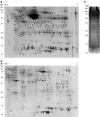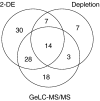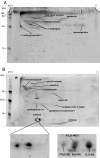Characterization of the Human Cervical Mucous Proteome
- PMID: 20461121
- PMCID: PMC2861172
- DOI: 10.1007/s12014-010-9042-3
Characterization of the Human Cervical Mucous Proteome
Abstract
INTRODUCTION: Cervical cancer is among the most common cancers in women worldwide. Discovery of biomarkers for the early detection of cervical cancer would improve current screening practices and reduce the burden of disease. OBJECTIVE: In this study, we report characterization of the human cervical mucous proteome as the first step towards protein biomarker discovery. METHODS: The protein composition was characterized using one- and two-dimensional gel electrophoresis, and liquid chromatography coupled with mass spectrometry. We chose to use this combination of traditional biochemical techniques and proteomics to allow a more comprehensive analysis. RESULTS AND CONCLUSION: A total of 107 unique proteins were identified, with plasma proteins being most abundant. These proteins represented the major functional categories of metabolism, immune response, and cellular transport. Removal of high molecular weight abundant proteins by immunoaffinity purification did not significantly increase the number of protein spots resolved. We also analyzed phosphorylated and glycosylated proteins by fluorescent post-staining procedures. The profiling of cervical mucous proteins and their post-translational modifications can be used to further our understanding of the cervical mucous proteome.
Figures




References
-
- Elstein M. Cervical mucus: its physiological role and clinical significance. Adv Exp Med Biol. 1982;144:301–18. - PubMed
Grants and funding
LinkOut - more resources
Full Text Sources
